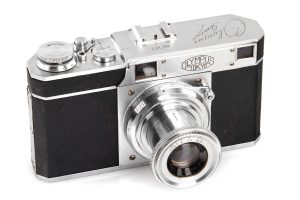Olympus Standard Prototype
1937, 4×5cm pictures on 127 film

Sensational discovery of the first Olympus camera: Only 10 of these Prototypes were made (nos.101-110), only three are known to exist (nos.102, 107, 110). Exactly this camera no.107 was used to advertise the new Olympus product in Asahi Camera magazine from November 1937. It comes with the matching interchangeable Takatiho Tokyo 3.5/65mm lens no.1304.
The Olympus Standard (オリンパス・スタンダード) is a rangefinder camera, made in 1937 by Takachiho (predecessor of Olympus) as a prototype camera. It takes 4×5cm pictures on 127 film. It has a coupled rangefinder combined with the viewfinder, and a focal plane shutter with T, B, 20–500 speeds. The advance knob is at the right end of the top plate, as seen by the photographer. It simultaneously advances the film and winds the shutter, and its base is surrounded by an exposure counter. There is a red window at the left of the back, protected by a sliding cover and used to set the first exposure. The back is opened by a key under the camera, and is removable together with the bottom plate. There is a plate under the camera at the center, that slides forward to act as a support leg. Inside the back, the camera has a removable pressure plate, said to be made of aluminum. On the top plate, immediately to the left of the advance knob, there is a hole for a distant release connection. The shutter release itself is just behind, combined with a two-position selector, marked T and I. It is said that this selector is used for film loading, to disconnect the film advance from the shutter operation. When set on the T position, the coupling mechanism is disengaged and the film is freely wound until the number 1 appears in the red window, then the exposure counter is manually reset to zero and the selector is switched to the I position for normal operation. (It is possible that the same selector is also used for T exposures, hence the T and I indications.) To the left of the distant release hole is the shutter speed selector, with the following positions: B, 20, 30, 50, 100, 200, 500. Just to the left there is a step in the top plate, corresponding to the viewfinder window, with a small arrow engraved to indicate the selected shutter speed. The accessory shoe is slightly offset to the left, and the serial number is engraved just in front of it: No 107. The left end of the top plate is engraved Olympus Standard in cursive script. The rangefinder window is at the left end of the body. Between the two windows is an OLYMPUS TOKYO logo. The same logo is also embossed in the back leather, on the right. The Olympus Standard has an interchangeable lens, screwed to the front of the focusing helical. The helical itself is attached to the body and does not come off, the same as on the Contax. It is driven by a tab and has an infinity lock. Quite unusually, the distance scale is fixed and the depth-of-field indications are on the rotating part. No other lens mount is visible, and it is unclear how the tele and wide angle lenses would have been focused or coupled to the rangefinder. The standard lens is a Zuiko 65mm f/3.5, with an all chrome finish. It is collapsible, with an internal three-lug bayonet to maintain the extended position. The aperture ring is on the front and the aperture scale goes from 3.5 to 22. The lens bezel is black, with the following marking in white: Takatiho Tokyo No.1304 Zuiko 1:3.5 f=65mm.
Photo credit: © WestLicht Photographica Auction
